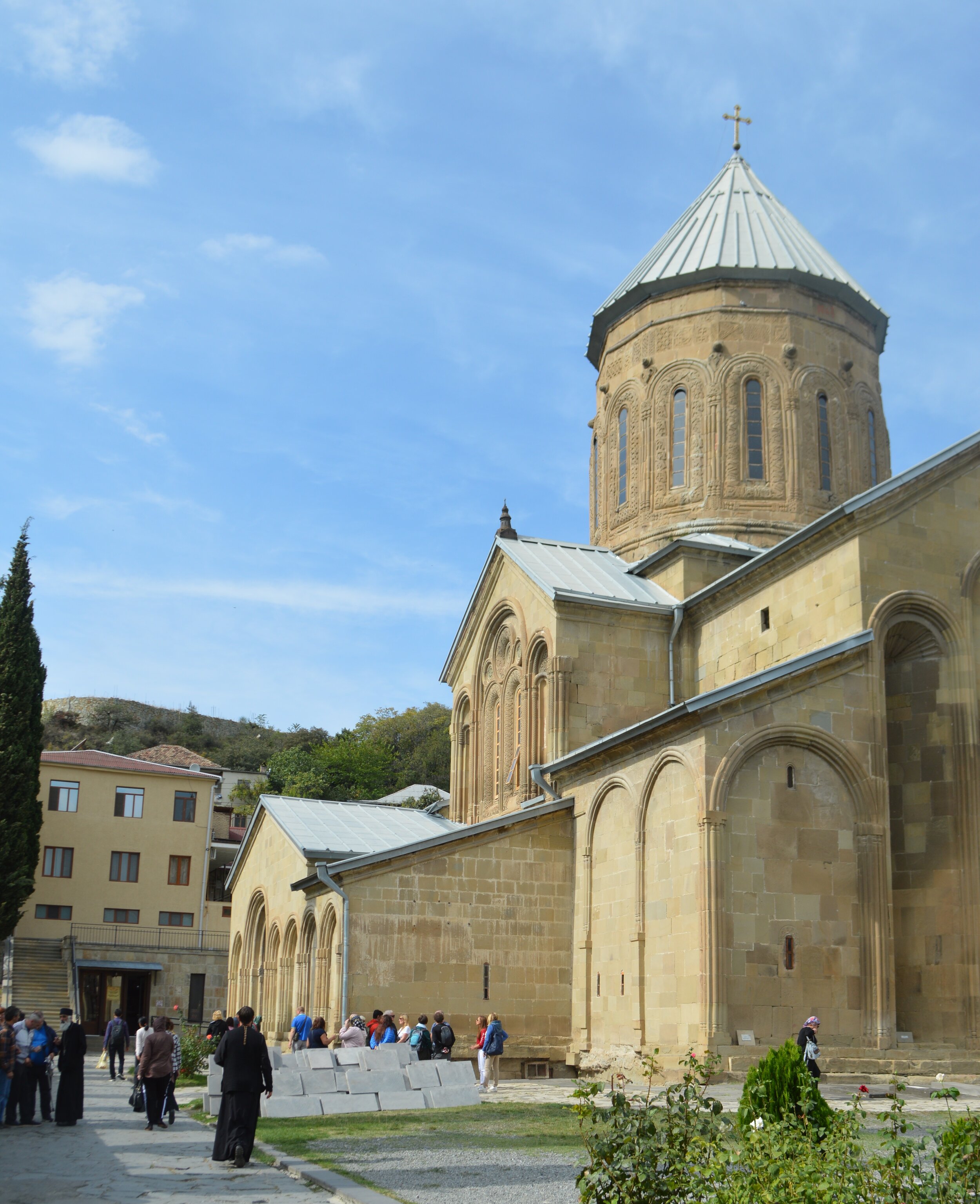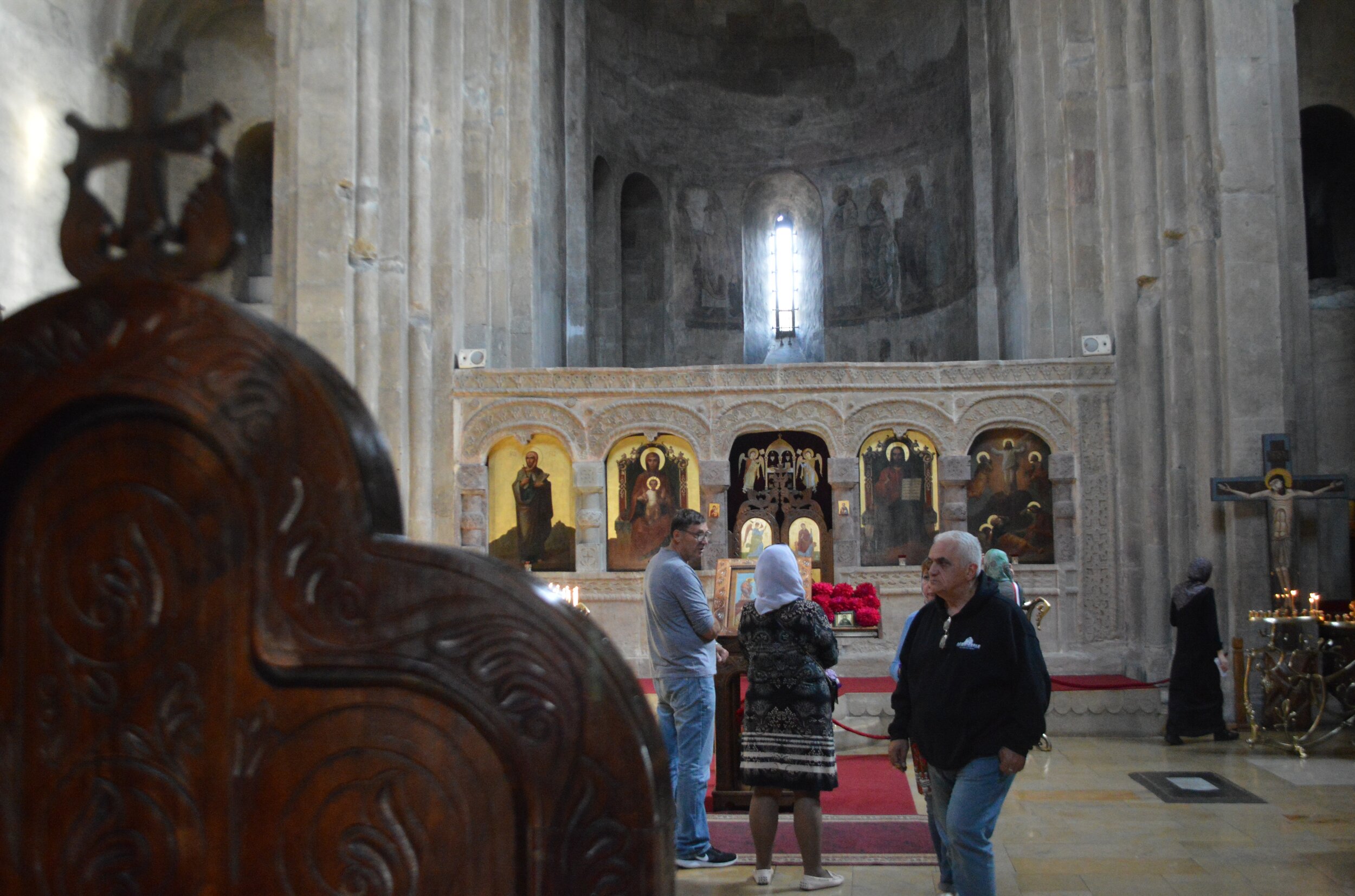The Georgian Saint revered for fighting Soviet communism
A woman prays at a shrine inside Samtavro church in Mtskheta, Georgia. Photo by Paul Brian.
MTSKHETA, Georgia — On May 1, 1965, Soviet authorities in the small republic of Georgia were holding the annual Workers’ Day Parade when something highly unexpected happened. A Georgian Orthodox Christian monk named Gabriel Urgebadze lit a massive 26-foot portrait of Vladimir Lenin on fire after dousing it with oil from a small lamp.
Then Urgebadze preached to a stunned crowd. The authorities were furious. Above the painting, the illuminated words “Glory to Lenin the Great!” were licked by flames.
St. Gabriel. Creative Commons photo.
“Why are you bowing down before idols?” Urgebadze asked the crowd. “Jesus Christ died and rose again, but your cast idols will never be resurrected. Even during their life they were dead!”
Today, Urgebadze -- who died in 1995 and became St. Gabriel in 2012 -- is revered across the country and the wider Orthodox Church as a holy man who guided the nation in its darkest times and now brings miracles to the faithful. A small and mountainous country of less than four million, about 83% of Georgians identify as Orthodox Christian, and only half of those Christians say religion is very important in their lives, according to Pew research.
St. Gabriel is regarded in the church as both a prophet and a healer, and a Georgian patriot who cried to God on behalf of the struggles of his nation, including its civil war in the fall of 1991. Oil from the lamp by St. Gabriel’s grave is also considered by believers to have miraculous healing powers.
Before St. Gabriel was blessed with a feast day (Nov. 2), honor and sainthood, he suffered for his activism. After burning Lenin’s portrait, people threw rocks at him, dragged, kicked and almost beat him to death, inducing a month-long coma. Upon waking, St. Gabriel was sentenced to death, but given a way out by authorities if he would admit that there was a concerted conspiracy within the church to overthrow and sabotage the Soviet communist government. He refused, despite more rounds of grievous torture, which soon drew international media attention.
So Soviet authorities decided to hold St. Gabriel in a psychiatric institution instead of killing him. He lived in the facility for seven months, classified as a schizophrenic psychopath whose belief in God was part of his mental delusions.
After his release, St. Gabriel endured years of unemployment and separation from the church. He preached on the streets, drinking and begging. Only strangers would give him money, and his former friends and acquaintances often mocked or ignored him.
St. Gabriel is buried in Samtavro Church in Mtskheta, Georgia. Photo by Paul Brian.
But eventually, St. Gabriel once again found a place in the church. By 1971, he became the priest at Samtavro convent and seminary in Mtskheta and entered the monastic cell there. Later recognition of St. Gabriel as a Holy Fool for Christ is part of a long tradition in the Orthodox Church for people who act outwardly absurd or in unexpected ways but are in fact doing God’s work by challenging convention and eschewing worldly approval, as reads I Corinthians 4:10: “We are fools for Christ's sake, but you are wise in Christ. We are weak, but you are strong. You are held in honor, but we in disrepute.”
Today the Samtavro church, convent and yard streams with worshipers and tourists at most times of the day. More than 100 pilgrims pray every day beside Gabriel’s elevated grave inside Samtavro Church, a 20-minute drive from Georgia’s capital of Tbilisi.
Pilgrims come from all over Georgia and from as far away as the United States, Russia and Asia. The faithful genuflect at icons, light candles and pray at the grave of St. Gabriel, often laying a hand on the glass encasement as they pray or kneeling to the ground with tears streaming from their eyes. Those leaving often have tear-filled eyes, too.
Nina Toradze, 29 from Tbilisi, said that St. Gabriel is a particularly important saint to her, who replenishes her peace of mind and brings healing to many.
“Whatever I ask him, it comes true. He can heal sick people,” Toradze said. “For me, he is important because he makes me feel at peace. He is a saint and helps people who are in need, I always come here when I feel down. I come here and ask him for whatever I need.”
Initially buried in four different Orthodox churches around the country, St. Gabriel’s believed-to-be-incorrupt remains were reburied at the special gravesite inside Samtavro in the spring of 2014. The Patriarch of the Georgian Church, Ilia II, announced later that year that an image of St. Gabriel that had appeared on the floor where his relics and bones rested prior to construction of the crypt were officially a miracle.
During his life, St. Gabriel would go on long journeys to visit run-down and abandoned churches throughout the USSR and support rebuilding. He always encouraged his congregants and colleagues to not give up hope.
“Always believe that our labor is not in vain,” he said. “Though many churches and monasteries are destroyed today or closed, the holy Angel sent by God sees and listens to our diligence and supplication, and brings our prayers to God with joy and makes Him aware of it. We find it difficult to do all these things now. We go in snow and slush, covered with plastic foil we have to deliver sermons, but time will come and these churches and monasteries will be rebuilt and services will be restored.”
Two young Georgian women visit Samtavro Church. Photo by Paul Brian.
St. Gabriel reportedly rarely allowed others to see him do miracles when he was alive, but on one occasion he reportedly proved the truth of the Holy Trinity to a Hindu man by visibly transforming bread into its component parts of fire, water and wheat with the sign of the cross and then re-blessing to turn it once again into bread, according to the church.
Testimonies of some of the miracles attributed to St. Gabriel describe praying with the holy lamp oil at St. Gabriel’s grave and then experiencing cures from brain cancer, cerebral palsy, life-threatening birth defects in an unborn baby, cirrhosis, childhood leukemia, recovery from a car accident, celiac disease, infant blindness and deafness, meningitis, an atrophied eye, Perthes disease, pathological paranoia, burn injuries, difficulty becoming pregnant, schizophrenia and kidney stones. One unnamed individual naming themselves only as an anonymous pilgrim writes that Father Gabriel is the “greatest saint of our times” and says praying to St. Gabriel cured him of sarcoma.
Inside Samtavro Church in Mtskheta, Georgia. Photo by Paul Brian.
There is a certain special presence and feeling inside the church and especially near the grave of St. Gabriel that is hard to explain, but that is very much noticeable and powerful. Non-believers call it simply the atmosphere of an emotionally-charged, venerated location, and believers say it’s the effects of St. Gabriel’s miracles and life of piety and the workings of the Holy Spirit.
Manana Burchuladze, 52, from Tbilisi, said St. Gabriel is incredibly dear to her and has even helped cure life-threatening diseases. She estimated that 100 to 200 people a day or more often come to pray at his grave.
Speaking outside Samtavro in early October of this year, Temuri Butskhrigidze, 38, said that he knows people who have experienced miracles after praying earnestly at the grave of St. Gabriel. He said he comes to pray here about twice a month.
“Father Gabriel is a very important saint,” Butskhrigidze said. “We ask him to give us health and we pray to him to give us what we need. I have not experienced miracles myself, but I know from my friends and relatives that someone we know was healed, someone could not speak and started speaking, could not hear and they started hearing, someone recovered from a very serious illness, someone had late-stage cancer and even they recovered. These cannot all be legends or lies, these are all true.”
Paul Brian is a freelance journalist focused on religion, politics and culture. You can visit his website at www.paulrbrian.com or follow him on Twitter @paulrbrian.





